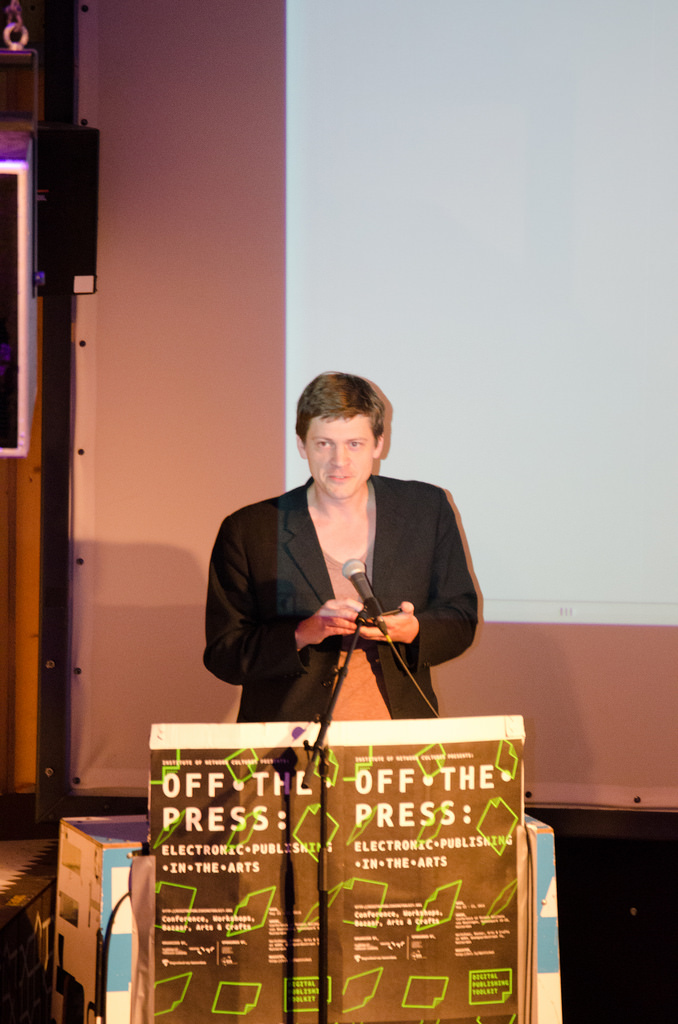 Publishing in the humanities holds many unrealized potentials online, argues Dušan Barok, the artist, writer and cultural activist who founded Monoskop (a wiki for art, culture and media technology).
Publishing in the humanities holds many unrealized potentials online, argues Dušan Barok, the artist, writer and cultural activist who founded Monoskop (a wiki for art, culture and media technology).
The Internet is not just a medium to distribute, store and manage e-books, he continues, but is in itself a medium that dictates specific means of reading and writing. As far as reading is concerned, many e-books are downloaded and bookmarked but in the end never read. Barok identifies the cause in that “they may contain something relevant but they begin at the beginning and end at the end” – in other words, their linearity is an obstacle for readers searching only for specific information. With full text search functionality available, why bother reading everything? Instead of humans, these e-books end up being read by machines. As far as writing is concerned, plain text might now be rendered to new formats like HTML, XML, wikitext or markdown, but Barok believes that coding holds an untapped potential in linking e-books to each other, much like referencing does in traditional publishing.
Thus, one of e-publishing’s most important unrealized potential is, in Barok’s opinion, contextual reading. An e-book is rarely a closed box; rather, it links to other content and authors, something that we formally know in traditional publishing as referencing.
Referencing has always been a trademark of writing and an act of comradeship in order to guide the reader to another writer’s passage. This is a laborious work with analogue books, since readers need to get up, go to the library or bookstore and find the other referenced book. On the web, this is a click away thanks to the hyperlink. The difference though is that in analogue books, referencing is done by writers, whereas with e-books the process is completely machinist. Both have their cons. The readers of analogue books rarely check the references and instead accept the interpretation of the referencing author (“the beauty of reading across references was never fully realized”, muses Barok). Are readers of e-books then more critical? Barok suggests not, as hyperlinking takes the readers to the whole referenced paper, and not the passage it directly refers to. The abundance of hyperlinks, especially in popular news articles, make it almost impossible for readers check everything. This lack of critical effort often paves the way for journalists and writers to manipulate others’ quotes, by taking them out of the original context or only quoting half the sentence. These deceptions can only be counteracted by the very few careful readers that would bother commenting on those articles, but what if the “Comments” section is closed? What happens to vigilance in online publishing? Isn’t e-publishing supposed to put author and reader in a more direct, bi-directional relationship? Or, for that matter, to allow e-publications to further connect to each other by means of referencing?
The major obstacle, argues Barok, is that e-publishing persists in old formats. In history, content has been written on stone, on columns, papyrus and paper. Writers have developed a framework that is here today: the use of grids, of paragraph, of punctuation, of arranging space. However, he explains, examples such as the early scriptio continua style (a text that essentially flows in one line) or Plato’s Phaedrus (originally written without any punctuation, word or paragraph separators) to illustrate how it is still possible to locate a passage regardless of how text is displayed and what tags it contains.
The essential difference between the medium of paper and that of code is that the latter has a completely different materiality. Despite this, we are still treating HTML codes to render page-like formats and follow grid rules, albeit the code itself could allow for much more exploration. The way that humans structure e-publications reflects old habits (pages need to be rectangular) or cultural habits (text letters to allow readability). What would happen if we renounced the use of grid and rather let text render itself according to the space we offer it – a good example for this is the conference’s interactive logo. Why is the technical possibility to reference-link directly to the passage rather than the entire document so little discussed?
“There is a tremendous amount of both old and recent texts online but we haven’t done much in opening them up to contextual reading”, Barok concluded. If the Internet is changing our way of reading, it is only to allow distraction from linearity, context and vigilance. To counter-act the latter, Barok suggests to authors, designers, publishers and developers to further explore ways in which referencing and content display can help readers engage with their e-books and immerse in new reading experiences. The way linking takes place on the web and the way scholars reference their works are two perspectives that could unite for a better communing of texts in e-publishing.


